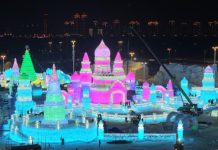BEIJING: A veteran former designer involved in the development of the J-10 fighter jet series has unveiled some of the secrets behind the iconic Chinese-made jet, which has recently been in the spotlight for its role in international conflicts.
The J-10 fighter jet, also dubbed “Vigorous Dragon,” is a single-engine, multi-role combat aircraft using a delta wing and canard design developed by the AVIC Chengdu Aircraft Industrial (Group) Co., Ltd. The J-10CE is an improved version of the J-10, designed for export as a single-engine, single-seat, multi-role third-generation fighter jet.
In an aircraft hangar in southwest China’s Chengdu City, Xie Pin, the former deputy chief designer who was involved in the development of the J-10 fighter jet, said that the J-10CE features collaborative combat capabilities, long-range multi-target strikes and multi-mode precision strikes against ground targets, even in strong electromagnetic interference environments. “It’s been over 40 years since development started for the J-10 series. But as you can see, it still looks so beautiful and modern. This fighter jet has a canard configuration. This is the canard wing. What’s the benefit of it? When it intersects with the leading edge of the main wing, it creates a vortex, and this vortex, after passing over the upper surface of the wing, increases the airflow speed, which in turn increases its lift,” said the 86-year-old designer.
Although its design dates back more than 40 years, the J-10CE remains a powerful fighter thanks to continuous technological upgrades. For example, to reduce its radar cross-section, the aircraft’s cockpit has been coated with a special film. Additionally, its intake has been designed with a unique structure, further enhancing its stealth capabilities.
“This intake is called a ‘clamshell’ intake. The intake is located underneath the aircraft’s fuselage, with a gap in the middle, allowing the low-energy boundary layer airflow to be directed into the gap and expelled. This helps reduce the aircraft’s drag. The weight of this kind of intake is also light,” said Xie. Over the years, radar and weaponry systems have undergone significant improvements, enhancing the aircraft’s capabilities in modern combat. These upgrades have substantially improved the aircraft’s operational range and firepower, making the J-10CE a formidable force in the sky. “In the past, the J-7 and J-8 fighters we worked on were ‘nearsighted.’ Why? Because they couldn’t detect targets at long distances. Now, with advanced radar technology, the J-10 fighter jet can detect targets up to about 200 kilometers. Additionally, the J-10 fighter jet has 11 external hardpoints, which can carry weapons, various pods and long-range, beyond-visual-range missiles. So it possesses formidable lethality,” said Xie. –The Daily Mail-CGTN news exchange item





